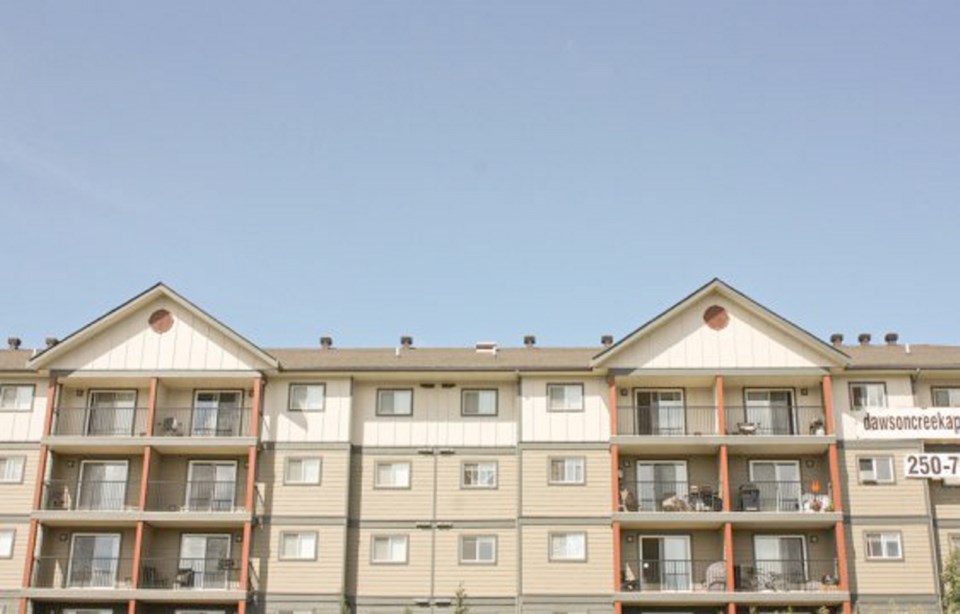Sara Duncan and her husband recently found a two-bedroom apartment in Fort St. John, but it wasn’t easy.
“I’ve lived in Vancouver and in Victoria, and the rent is higher here than it was there,” she said. “It would be impossible for someone who made less than $20 an hour to reasonably live here in a place that wasn’t absolutely terrifying, in a horrible neighbourhood.”
It was only through a friend of her husband’s that they were able to finally find somewhere to live.
In North Vancouver, Duncan said she paid $800 for a 1,300 square foot two bedroom with an ocean view. Now she pays $1,450 for an 800-square foot two bedroom.
For renters in Fort St. John and Dawson Creek, Duncan’s experience is all too common. This spring, tenants in those cities faced the second and third most expensive rents in the province, respectively, according to recently released data from the Canada Mortgage and Housing Corporation (CMHC).
So why are apartments so expensive in this corner of the province? Factors include high population growth, a limited stock of housing and a strong economy.
Northeast B.C. saw the fastest population growth in the province from 2013 to 2014, data from from B.C. Stats shows. Leading the region was Fort St. John with the second-highest rate in B.C. It grew 4.7 per cent to 21,523.
Dawson Creek, the second largest municipality within the region, grew about three per cent to 12,653 people.
High population growth drives rents higher because it takes municipalities and developers longer to build apartments than it does for people to move into them.
Since 1991, the number of rental units in Fort St. John has risen only 10 per cent, but the population increased 15 per cent, according to BC Stats.
It’s a similar story in Dawson Creek, where the number of rental units rose 10 per cent from 1991 to 2014, but the population shot up about 17.
Driving the region’s population growth is an abundance of jobs.
From October 2014 to February 2015, the unemployment rate in this part of the province was so low that it was almost impossible to measure. There were about 1,100 people without jobs in January, of a 41,600-strong labour force, according to data. It wasn’t until after spring breakup (when seasonal oilfield jobs evaporate) that BC Stats measured the rate at 4.7 per cent in April and 5.9 per cent in March.
Rent prices in the cities increased almost two times faster than general inflation.
Inflation drives rents higher, as well.
Twenty-five years ago, the average apartment cost $367 per month in Fort St. John and $349 in Dawson Creek. Had rent costs risen on par with inflation, they’d be $598 and $568 in Fort St. John and Dawson Creek, respectively.
According to the CMHC data, the average rent this spring for all types of row townhouse and apartment buildings in Fort St. John was $1,059 and Dawson Creek $1,005 — roughly 77 per cent higher than inflation.
This is much higher than many other cities in B.C.
Of the 22 municipalities that the CMHC has kept tabs on since 1990 (those with populations over 10,000), on average their rents rose only eight per cent faster than inflation.
Vacancy rates can also be tricky to measure in Dawson Creek and Fort St. John because so many jobs are seasonal — although not as many as in the past.
Generally, higher vacancy rates are supposed to translate into lower rents.
But the seasonal nature of Fort St. John and Dawson Creek’s economies tends to lessen that impact.
The annual vacancy rate for Dawson Creek has consistently been higher than the provincial average. The only exceptions were in the years 1994, 1997, 1998 and 2006.
The only year Fort St. John’s vacancy rate was lower than provincial average was in 2011.
One of the people who has been affected by rental prices is is Dawson Creek resident Daneka Hussey.
Hussey rented while saving up for a down payment on a home.
But she said that “a lot of people don’t have that option.”
For her, people in town may graduate from high school, and work in lower-end jobs while they decide what they want to do with their lives. Should they decide they want to upgrade their learning, they are burdened with higher rent.
“It’s impossible for you, if you’re paying $1,300 a month, to pay for tuition,” she said. “Availability is common now, but brand new units are so expensive that if you work a lower end job, you can’t afford it."



